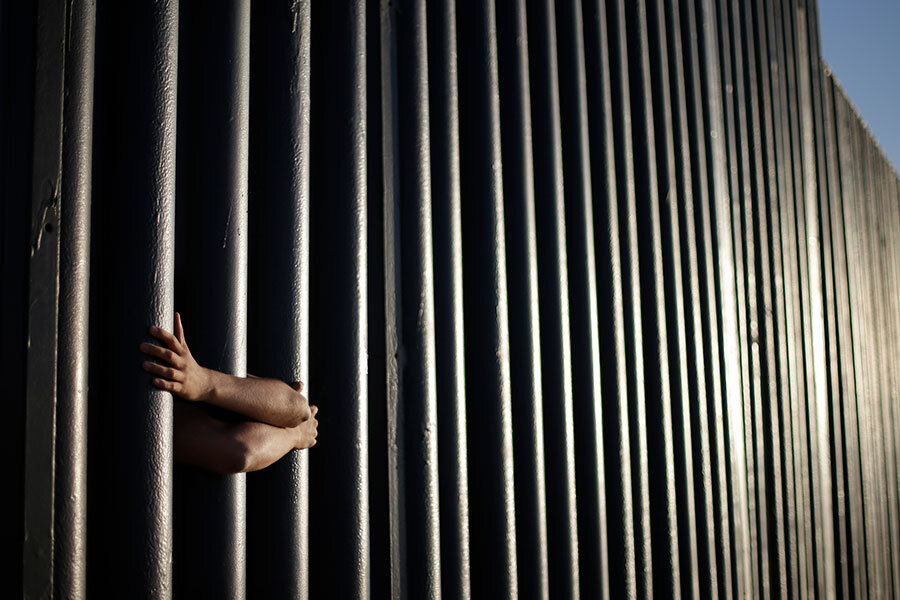Forget Mexico. Could solar energy pay for Trump’s border wall?
Loading...
By floating a simple suggestion, President Trump has single-handedly improved the prospects for his border wall: If Mexico won’t pay for it, maybe the wall can pay for itself.
In a meeting with Republican congressional leaders Tuesday, Mr. Trump suggested covering the wall with solar panels so the government can sell the electricity, according to Axios, an online news site.
That a coal-loving, clean-energy skeptic like Mr. Trump would propose solar panels to make his border project more palatable tickles the funny bone of the solar industry.
“If the reports of his comments are true, we are glad to hear that the president appreciates the many benefits of solar energy,” said Dan Whitten, a spokesman for the Solar Energy Industries Association (SEIA).
That doesn’t mean a “green” wall does anything to address the policy and moral objections that Democrats raise about physically cutting off the United States from Mexico.
"Just like painting stripes on a pony doesn't make it a zebra, solar panels on a wall no one wants doesn't make it any more attractive," Sen. Chuck Schumer (D) of New York said Wednesday in remarks on the Senate floor.
But the solar proposal could win over many conservatives who support the wall but worry about the costs. Could sales of clean electricity really cover construction costs?
In January, Jigar Shah of Generate Capital wrote a LinkedIn blog in which he estimated that a 2,000-mile solar wall could generate about 6.6 billion kilowatt-hours. At 6 cents per kWh, the wall could produce $15.8 billion worth of electricity over the 40-year lifespan of the solar panels.
The payback depends crucially on how much the wall actually costs to build. If the Trump administration is correct with its $12 billion estimate, a solar version would take 32 years to pay for itself.
If, however, the wall costs more than $21 billion, as an internal Department of Homeland Security report predicted, the payback period could easily stretch to 60 years or more.
Elemental Energy, a solar design and installation firm in Portland, Ore., puts the payback for a 1,000-mile border wall at a little over a century, even if the Trump estimate for construction is valid. That’s based on a lower revenue estimate than some others use.
These estimates assume the entire wall goes solar, which is unlikely given the difficult terrain that the border traverses. A more modest proposal comes from Thomas Gleason, owner of Gleason Partners in Las Vegas. He is one of more than 100 contractors who have submitted proposals to US Customs and Border Protection (CBP) to build the wall.
In his vision, solar portions of the wall would only be installed where likely users are nearby. The most obvious users would be the CBP itself, which would need electricity to power sensors and lighting; border cities and towns; remote rural residents who currently rely on diesel generators for electricity; and farmers along the border looking to irrigate crops with water from the Rio Grande.
The costs of building, say, a few hundred miles of solar wall in the most advantageous places, could make the payback far shorter.
Mr. Gleason’s design calls for a 12-foot concrete wall topped by eight feet of wire mesh with five rows of solar panels above that. The panels, unlike in the earlier estimates, would move with the sun. Each mile of his solar wall would cost $7.5 million to build and would generate about 2,000 kilowatts of electricity (a more conservative estimate than Mr. Shah’s, who figured on 2,500 kilowatts.)
With an average 7.25 hours of sunlight per day and electricity sold at 6 cents per kilowatt hour, the government would make $317,550 per year per mile in revenue. That means the solar portions of the border wall could pay for themselves in about 23 years and eight months.
If electric rates went up, the payoff would be faster, he points out.
Building 300 miles of solar wall would add about 600 megawatts of solar capacity to the US, less than a third of the capacity added in the first quarter of 2017 alone, according to the SEIA.
There's one final twist: Gleason says he has not heard from the CBP whether his proposal has been accepted in the second round of proposals. But the agency says it has already notified all the winning companies. So it appears that it has turned down the one publicly known solar wall proposal, which the president is now touting.








